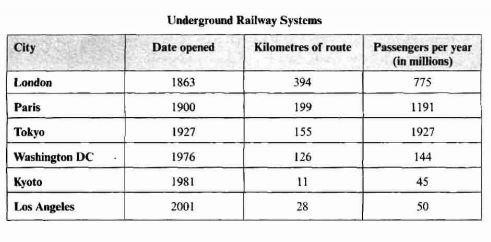The table below gives information about the underground railway systems in six cities.
Summarise the information by selecting and reporting the main features, and make comparisons where relevant.
The provided tabular chart shows statistical data about underground rail networks in six major cities.
Overall, six networks of subsurface railway systems are compared in terms of their eld, length of the route and the figure of commuters who board them per annum. It is evident that the three oldest underground systems are longer and assist considerably more passengers than the other three newer railways.
A glance at the table reveals that London has the oldest underground railways that commenced functioning in 1863. It also has the longest route with 394 kilometres. Paris is the second-largest system which is around half of the length of London’s tube, with 199 kilometres of route although it is boarded by more travellers per year in comparison to London. Furthermore, third in terms of length, Tokyo’s metro is clearly the highest used, receiving 1927 million passengers yearly.
Probing further, as far as remaining three newer metros are concerned, the Washington DC’s is the lengthiest of them three, with 126 kilometres. Los Angeles’ tube covers a distance of merely 28 kilometres and is the newest, having opened in 2001 and 50 million people move around by using it. Whilst the Kyoto network is the shortest route of only 11 kilometres and serves 5 million passengers less per year than that of L.A.
Vocabulary:
eld: old age
commuter: frequent traveller
glance: a quick look
reveal: shows
commence: start
Probing: investigation

